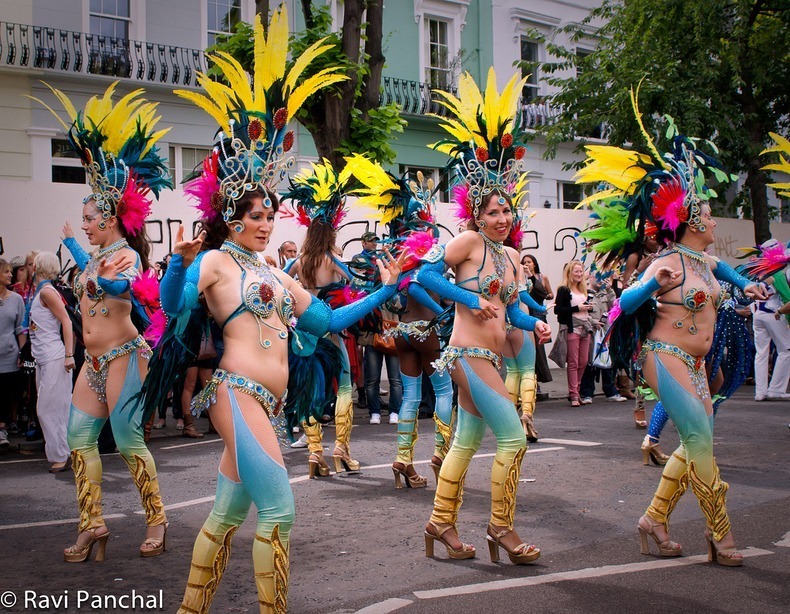A year ago, we scoured every nook and corner of the earth and rounded up some of the strangest festivals celebrated every year in the month of August. We’ve found another bunch that deserves a place on the list, hence this second edition.
Amsterdam Pride
Amsterdam holds one of the most popular Gay Pride celebrations in Europe, drawing revelers from all over to partake at a week's worth of parties and arts and cultural events, culminating with the famously colorful Amsterdam Canal Parade. Tens of thousands of festival-goers, many dressed in pink or wearing studded leather, party it up at one of the city's biggest events. A variety of street festivals, circuit-style nightclub parties, arts and cultural presentations, and sporting events are staged throughout the week leading up to the big weekend, starting on Saturday.
On Saturday afternoon some 80 fancifully decorated boats sail through the city's ancient canals, each with its own theme, pumping out dance music. That evening, the fun continues with more street festivals and parties. More than 300 different events take place in conjunction with Gay Pride Amsterdam.
kaZantip
kaZantip, also known simply as "Z", is an electronic dance music festival held every year on the Crimean peninsula in Ukraine. Over a period of 5 to 6 weeks in the summer, international DJs and 150,000 revelers pop in an out of the peninsula with an eccentric theme of orange coloured fashion and yellow suitcases.
KaZantip presents itself as a "virtual republic" with over 300 DJs on more than 14 dance floors which play 21 hours per day. The festival is held on a piece of land covering 60,000 square metres. Despite its small size, the “Republic” fits, aside from the dance floors, around 30 bars and restaurants, 2 open air cinema halls, 3 kite-surfing stations and an a number of weird architectural structures. All of this is fitted with light and sound and, when the night comes down, looks pretty much like an extraterrestrial space base.
Referred to as the festival of "sea, sex and summer”, KaZantip is often compared with Ibiza and Burning Man – a hangout for DJs, beautiful girls, dancers as well as freaks and psychos obsessed with self-expression and neo paganism.
Rhine in Flames
Rhine in Flames or “Rhein in Flammen” is a fireworks spectacular that takes place along the most scenic stretches of the Rhine every year between May and September. On the five different dates, brightly illuminated ships sail the river in an evening convoy for their passengers to see the full firework display which begin as the flotilla arrives. Besides the eye catching fireworks, castles, palaces and riverside promenades are decorated in Bengal lights – their glow reflecting in the flowing waters offer a mesmerizing view. On the river banks wine festivals take place, along with music and dancing, that attract hundreds of thousands of visitors every year. The biggest "Rhein in Flammen" event takes place in Koblenz every year, on the second Saturday in August.
Notting Hill Carnival
Notting Hill Carnival takes place on the streets of Notting Hill, London, each August, over three days. It was originally led by members of the West Indian migrant community in London, in particular those from Trinidad and Tobago. The carnival has attracted around one million people in the past years, making it one of the largest street festivals in the world.
The first Notting Hill Carnival took place in 1959 in St. Pancras Town Hall as a response to the depressing state of race relations at the time. UK's first widespread racial attacks (the Notting Hill race riots) had occurred the previous year. The first carnival organized by Claudia Jones from Trinidad and Tobago, who is widely recognised as "the Mother of the Notting Hill Carnival", was a huge success, despite being held indoors. A few years later in 1966 the first outdoors event was organized, inspired by the London Free School and the hippie movement. The aim of this event was to promote cultural unity, and was spearheaded by Rhaune Laslett, a community activist. What started as a street party for local children turned into a carnival procession that we see today.


Bathtub Regatta
Each year on August 15, the city of Dinant, Belgium, 100km southeast of Brussels, hosts the Bathtub Regatta. Floating decorated bathtubs race on the Meuse River attracting crowds as 25,000 who watch this procession of bizarre boats racing. In addition to bathtubs, visitors will see homemade rafts, floating waterslides and other curious boat-like creations. A theme is selected each year for the regatta and participants enthusiastically incorporate it into the creation of their boat with a heavy dose of humor.
Inspired by a story he heard on the radio about a Frenchman sailing down the river in tub, Dinant’s famous moustached chef, Alberto Serpagli, found about 40 abandoned tubs in nearby Charleroi, and sold them at the local market as part of his grand idea. On 15 August 1982, those who bought the tubs launched their boats into the water and the first bathtub regatta was born. The regatta is held on the same day every year, but has grown since. About 50 tubs compete each year, but no limit exists on how many people can ride on a single craft.
Go Topless Day
Go Topless Day, also known as National Go Topless Day or International Go Topless Day, is an annual event held to support the right of women to go topless in public on gender-equality grounds. The event is held every August around the time of Women’s Equality Day, which marked the passage of the 19th Amendment, in 1920, allowing women to vote.
The annual event was established in 2007 by American organization "Go Topless". To promote gender equality, the event encourages women to go topless in public, and men to cover their chests by wearing brassieres or bikinis.



























Comments
Post a Comment